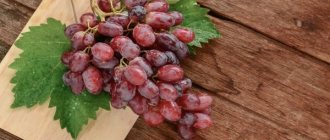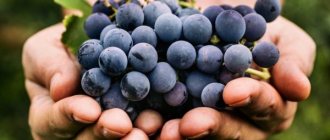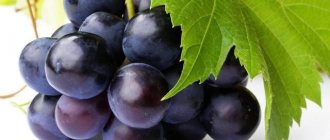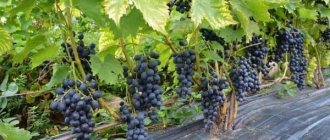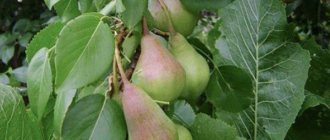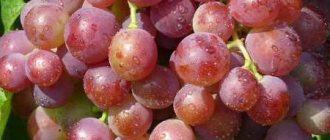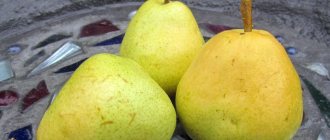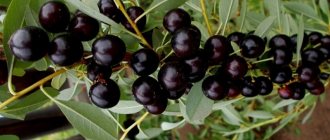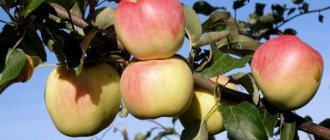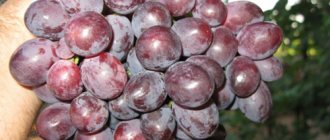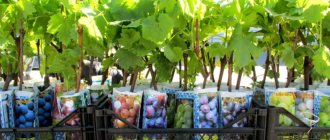When starting to grow grapes, it is important to choose the right variety. It must be sustainable, fast-growing, productive and tasty. In Siberia, frost-resistant varieties are grown, with good ripening and restoration of the vine. In this article I talk about 10 proven grape varieties that you can plant on your plot and confidently expect a generous harvest. I provide a photo and a detailed description.
This article will focus on proven varieties that will successfully complement your vineyard:
- Augustine,
- Agat Donskoy,
- Muscat white,
- White Muscat Shatilov,
- Platovsky,
- Beauty of Nikopol,
- 15-03-1,
- Amursky No. 1,
- Amursky No. 2,
- Delight.
I selected table and technical varieties with early and mid-early ripening periods from 105 to 125 days, with frost resistance down to -29 ° C, with vine ripening of 80-90%, large clusters and decent taste of berries with a tasting score of up to 4.5 points.
Photo: Augustine grapes
Augustine
This variety has synonymous names: V 25/20, Pleven resistant, Phenomenon. Bred by NIIViV, Pleven, Bulgaria. A worthy large-fruited table variety. It is characterized by increased resistance to diseases and cold. It is considered unpretentious and consistently fruitful.
- Bisexual, early grape variety (110–115 days), vigorous.
- The bunch is large (300–500 g), conical, of medium density.
- The berries are large, white, oval, weighing 4–5 g, the taste is harmonious.
- The vines ripen up to 80%.
- Sugar content – 19–21%, acid – 6–7 g/l, tasting score – 4.5 points.
- Transportability is high. Commodity.
- Resistance to diseases and frost (-24–25°C).
Sheltering the vine for the winter
At the beginning of October, to protect the vine from frost, it is removed from its support. Ideally, over the summer, one or two strong shoots grow on the seedling, about one and a half meters high (the stepsons were pinched as they appeared throughout the summer). The shoots are cut so that three or four buds remain and pressed to the ground. It is better to lay the above-ground part on some kind of bedding, which can be polyethylene or a synthetic substrate under the laminate. To prevent the vine from bristling, its branches need to be tied together with twine.
Next, you need to press the bush to the polyethylene bedding using metal staples. They can be made by cutting thick wire into pieces 30 or 40 centimeters long. The staple is pierced into the ground, while the vine passes under the arc and is pressed against the ground. Depending on the length of the grape bush, there may be several staples; they are placed at a distance of 50-70 cm from each other.
The staple can be replaced by a wooden hook, which is a stick, about 40 centimeters long, with a knot. The stick goes deep into the ground, and the twig presses the vine to the ground.
A small greenhouse is created above the grapes. Its frame is made of low wire arches, to which a long pole is attached on top with tape or wire. In the future, the pole will prevent the snow mass from pushing through the greenhouse frame and lying on the vine.
Any available covering material is placed on top of the frame:
- cardboard;
- roofing felt;
- unnecessary linoleum;
- old palace
The width of the material covering the greenhouse frame should be about 1 meter, that is, such that the edges do not hang from the arcs, but overlap the ground. The covering material must be waterproof, so when using cardboard or carpet, a film or thin laminate backing is placed on top.
Protection will be effective if a layer of earth is poured onto the edges of the covering heat-insulating material on the right and left. At the same time, the ends (front and back of the greenhouse) remain open for air access. In November, it is necessary to close the ends and dig the edges with earth.
A winter hut for a vine can be considered ideal if you throw spruce branches, dry branches or cut sunflower stems on top. Branches and stems will be able to hold back the first snow on the roof of the greenhouse and create comfortable conditions for insulating the grapes as quickly as possible. Now the plant is not afraid of even 45-degree frosts.
Agat Donskoy
Bred by Russian breeders VNIIViV named after. Ya. I. Potapenko, also has the name Vityaz. Frost-resistant, disease-resistant and high-yielding.
- Medium ripening period (115–125 days; early September).
- The bushes are vigorous.
- The bunch is large (up to 400 g), conical, medium-dense.
- The berries are large (4–5 g), round, black, insipid in taste.
- Sugar – 13–14%, acid – 6–7 g/l, tasting score – 4.0 points.
- The vines are 85–90% ripe.
- Transportability is average.
- Withstands -27°C, disease resistant.
___________________________________________
For a detailed review of the variety and cultivation features, read this article
Photo: Agat Donskoy grapes
Cleaning hibernation
At the beginning of spring, when the snow has melted and the sun has warmed up, the vineyard is approaching a new cycle of its development. Armed with a short-handled shovel, we approach the bush and remove the top layer of soil. Carefully, without damaging the grapes themselves, we place the top soil next to the hole in which the bush is planted.
We remove the coating up to a maximum of fifteen centimeters. We are talking only about cultivated varieties of bushes, since winter-resistant varieties do not require earthen shelter. And sometimes there shouldn’t even be a fabric covering in the hole in which the rhizome overwintered. Otherwise, steaming of the roots will occur.
Muscat white
Technical grade, also called 16–1–23, obtained at NIIALM, Volgograd. Valued for its high sugar content, it is used to make aromatic and tasty Muscat wine.
- Extra early (third–fourth decade of July), medium height.
- The bunch is medium (more than 250 g), cylindrical, dense.
- The berries are round, light yellow (2.5 g), nutmeg aroma.
- Tasting score – 4.5 points.
- Vine ripening up to 90%.
- Frost resistance (-25°C), disease resistance is average.
_______________________________________________
For a description and photo of early harvest grape varieties for Siberia, see this article
How to choose the right variety
To grow a healthy bush that will produce a good harvest, you need to learn how to choose the right variety.
Important! The climate of Siberia has its advantages: in such conditions the risk of infection with phylloxera or downy mildew is reduced.
The following characteristics are taken into account:
- Direction . It is necessary to decide for what purpose the grapes will be grown: table, industrial or universal.
- Winter hardiness . Only frost-resistant varieties that tolerate temperatures of -25°C and below are suitable for Siberia.
- Productivity . This is an indicator that characterizes the productivity of a variety.
- Maturation periods . High yields in frosty conditions can only be achieved by early varieties.
White Muscat Shatilova
Launched by OSSiV, Orenburg, F.I. Shatilov. A vigorous hybrid with a very large leaf, high-yielding, bisexual. Pruning the entire mature vine, since the inflorescences distant from the head of the bush are larger.
- Early variety (115–120 days).
- The bunch is large (500–1000 g), already in the first year it can be 1500 g, the shape is conical, loose.
- The berry is round, yellow, fleshy with a harmonious nutmeg aroma and pleasant taste, weighing 5–6 g.
- Ripens in mid-August.
- The vines ripen very well, almost completely.
- Frost resistant (-27°C).
Frost-resistant, uncovered variety, suitable for growing in Siberia and the Urals.
Photo: white Muscat grapes Shatilova
White, dark and pink varieties
White grapes are distinguished by their sweet and sour pulp . It is eaten fresh or used for preparations. The universal variety of white grapes Rusbol is frost-resistant, can withstand temperatures as low as -25°C, and is resistant to mildew. The berries are oval, the taste is sugary and pleasant. Productivity is about 10 kg per plant.
Bazhen grapes also perform well in harsh climatic conditions . The flowers are bisexual, the berries are long, the weight of one is about 13 g. The color is yellow-green, the fruits shimmer in the sun. The taste is sweet and harmonious. The shoots ripen quickly and uniformly, and the bisexual flowers provide stable yields.
Grapes "Bazhena"
Of the pink varieties, the varieties Preobrazhenie and Muscat Pink are distinguished . They are early ripening, require shelter for the winter, and are sensitive to mineral and organic fertilizers. The fruits are red-pink, dense and elastic, oval-ovoid in shape. The varieties are frost-resistant, rarely suffer from oidium, powdery mildew, mildew and fruit rot. The harvest is used in fresh and processed form; the berries are distinguished by their transportability and shelf life.
Grapes "Transfiguration"
Dark varieties are mainly used for processing; dry and semi-dry wines and wine-containing drinks are prepared from them. In addition to the Kodryanka variety, the dark grape Black Cherry is popular. The clusters are loose, the weight of one reaches up to 1000 g. The color is dark purple, the peel is dense, the flesh is light pink. The variety is early-bearing and begins to bear fruit in the second year after planting. The berries are crunchy and tasty, with a pleasant sweet aroma.
Platovsky
A proven variety for risky farming areas. Received from VNIIViV named after. Ya. I. Potapenko. Frost-resistant, the vines recover well after frost. Technical high-yielding wine variety, weakly affected by diseases.
- Technical variety, early ripening (110–115 days), medium-strong growth vigor.
- The clusters are cylindrical, medium in size (200 g), moderately dense.
- The berries are medium (2 g), round, white, pinkish in the sun.
- The taste is harmonious. Sugar – 20%, acid – 8%, vine ripening up to 80%, load – 60 buds, frost resistant (-29°C).
- Wine, high quality.
How to plant a vine in a harsh climate
The best time for planting is May and June, although winter-hardy varieties successfully take root in the autumn. It is better to place the line for placing grape bushes from north to south. A landing trench is formed along the line, sixty or seventy centimeters deep. The edges of the trench can be vertical or sloping.
At the bottom of the trench, the soil is dug up to a depth of about thirty centimeters. All weeds are removed. Fertilizer is applied. For one bush you will need:
- rotted manure - 1 bucket;
- superphosphate - two hundred grams;
- wood ash - glass.
Planting holes are dug at the bottom of the trench, each about 50 - 60 centimeters deep. The distance between the pits is about two and a half meters. At the time of planting, the ground temperature here should be above fifteen degrees Celsius. Seedlings (one-year or two-year-old) must be treated - cut off the heel (lowest) roots, leaving ten or twelve centimeters, and soak for 24 hours in heteroauxin (one tablet per ten liters of water).
The treated seedling is lowered into the hole so that the top is barely visible from it. Lightly cover the roots with the soil mixture, pour out a bucket of warm water and fill the hole completely. The height of the shoot above the ground should be 10-12, but not more than 15 centimeters.
The seedlings are covered with a film placed on wire arches. On hot days, ventilation is necessary - the film rises at the ends. It is possible to completely remove polyethylene only when the onset of night frosts can no longer be feared.
To support the vines, wooden poles about two and a half meters high are dug into the ground. Wire is stretched between the pillars at different heights. The tree trunk circle is mulched with straw or wood chips .
Near the vine, at a distance of four meters, you should not lay paths or make plantings. The ground can be covered with corrugated cardboard to prevent weeds from growing. There is no need to remove fallen leaves, loosen or weed. Watering is required rare but plentiful so that the soil is saturated to a depth of about eighty centimeters. Fertilizer - in spring and autumn. In this case, it is worth alternating the application of organic matter (compost, rotted manure, bird droppings) and inorganic fertilizers (ammonium nitrate, superphosphate, potassium sulfate).
The ratio of the amount of inorganic fertilizers is calculated as follows: for every kilogram of harvested crop, the soil needs to return six grams of nitrogen, two grams of phosphorus and four grams of potassium. Practical calculations for applying fertilizers per kilogram of harvested crop are made as follows:
| Active substance | Calculation | Soil application (grams) |
| Ammonium nitrate nitrogen-34% | 6 : 0,34 = 17.6 | Around 18 |
| Superphosphate Р2О5 – 20% | 2 : 0,2 = 10 | 10 |
| Potassium sulfate K2O – 50% | 4 : 0,5 = 8 | 8 |
Beauty of Nikopol
One of the best varieties for Siberia and the Urals. Very early, resistant to mildew, oidium, gray rot. The bushes grow strongly, the shoots ripen well.
- Table grape variety with very early ripening period (105 days).
- In the Rostov region it ripens at the end of July.
- The bunch is medium (400–600 g), medium dense, conical.
- The berry is oval, weight – 4–5 g, purple.
- Productive (one of the best early varieties), highly marketable.
- Sugar – 18–20%.
- The pulp is fleshy and juicy, the taste is harmonious.
Technical and canteens
Technical varieties are grown for processing - wines, juices, champagne, and cognac are made from grapes. Yield technical variety - Ruby Azos. Medium late, fruits are harvested in September. The clusters are branched and loose, weight is about 300 g. The berries are round, the weight of one is 2 g. The skin is dark blue, the rind is dense, the flesh is sweet and juicy. Tasting score: 7.9 points. Among the advantages of the variety are increased resistance to diseases and pests.
Grapes "Rubin Azos"
Another technical frost-resistant variety is Ryabinsky . Early ripening, self-fertile. The plant is medium-sized and does not require special skills to grow. The weight of the bunch is 180 g, the berries are dense, oval, white in color. The pulp is juicy, the taste is simple, the juice is colorless. Ryabinsky grapes are used to make dry wine - the tasting score is 7.8 points. Grapes are rarely affected by diseases and require shelter for the winter.
Dining rooms
Table varieties have sweeter and more pleasant pulp, thin skin, and delicate taste . Variety Skungub 2 is universal to use and unpretentious to grow, with frost resistance down to -25°C. The bushes are medium-sized, the leaves are slightly pubescent. The clusters are medium dense, weigh about 230 g, the berries are black and oval. The taste is pleasant, the tasting rating of fresh grapes is 8.4 points.
For fresh consumption, gardeners grow table grape variety Yubileiny Skuinya . The bushes are medium-sized, the weight of the bunch is 200 g, the shape is conical-cylindrical. The berries are oval, light green in color, the pulp has a harmonious taste, sweet with a pleasant sourness. To obtain a rich harvest, it is recommended to carry out fan pruning annually and remove old dry shoots.
Grapes "Jubilee Skuinya"
15–03–1
A high-yielding variety of Orenburg selection OSSiV, bred by F. I. Shatilov. Suitable for growing in Siberia and the Urals.
- Vigorous.
- The bunch is medium (300 g), conical, very dense.
- The berries are elongated, dark purple, have a simple taste, weight – 4 g.
- Sugar content – 22%, acidity – 6.7%.
- The yield is high - 12–15 kg, frost-resistant (-27°C).
Photo: grape hybrid Shatilov 15–03–1
History of Siberian grapes
Grapes appeared in northern latitudes about 70 years ago. Enthusiasts and professionals began actively promoting culture in these areas back in the 40s and 50s. The healing properties of the berry, the ability to obtain a rich harvest, even in the most difficult conditions, the potential for the development of domestic winemaking - all this became the impetus for active development in the area of selection. Even under Stalin's rule, projects were opened to develop frost-resistant varieties.
The next stage of development was the attempts of local breeders and hobbyists to expand plantings to experimental areas, commercial ones, and to make the crops widespread outside the Urals. Clubs and schools of Sharov and Levchenko were created, which made a significant contribution to development.
On a note! Even today the vineyards of the Solovetsky Monastery are widely known. The harsh climate of the White Sea coast did not become an obstacle to the cultivation of several plant varieties at once.
Amursky No. 2
Many characteristics are similar to the previous variety.
- Bisexual. Bunch – 150–170 g.
- The berries are medium (3–4 g), black, have a pleasant taste, juicy, ripen in August (ripening period - 90 days).
- The yield is high, the vines ripen by 90%, the variety is universal, not covered.
- Sugar – 18–20%.
Garden grapes Pearl Saba: its main characteristics
Like the previous grapes, Zhemchug Saba belongs to the table variety, very early ripening. Its growing season lasts about 100 days, which makes grapes very attractive to gardeners. The size of the berries themselves is very small and reaches its maximum of 4 grams; the clusters are correspondingly also small in size (300 - 500 grams).
The average, and in some years, low yield of this variety worries gardeners. Pearl Saba is a high-quality grape variety. It has a sweetish taste. It has a slightly oval shape and a yellowish-light green color.
Delight
Zoned in many regions and in Orenburg, received at VNIIViV named after. Ya. I. Potapenko. The best variety of breeder Kostrikin, the founder variety in the “Vostorgov” family and many other varieties.
- Early (110–120 days).
- Ripens by the second ten days of August.
- The bunch is large (500 g), conical, medium density.
- The berries are large (4–6 g), slightly oval, white.
- The shoots ripen well.
- Sugar – 18–22%, acid – 5–9 g/l.
- Resistance to frost (-25°C) and diseases is high.
- Transportable.
Difficult climatic conditions
In the center of Russia, climatic conditions are quite specific. Strong wind currents, long winters, low climate temperatures, and short summers quite shorten the seasonal growing season of the plant. But there were still successes. Vineyards took root in Altai and during this period the first batch of test wine was made from seven different grape varieties. However, not everything continued so wonderfully. Brezhnev decided to end the fairy tale. An order was given to eradicate all vineyards in that area. And the prosperous period of Siberian selection ceased. It would seem that all progress was destroyed at dawn. But the further growth of the vine continued with the help of lovers of this business. Some of them even opened their own schools and institutes of viticulture in order to pass on their accumulated experience to others. Thanks to them, today any Siberian summer resident is able to provide himself with grapes throughout the year.
“Trouble-free” varieties for the beginning winegrower
The grape varieties offered are maximally adapted to Siberian conditions, require minimal care, are high-yielding, hardy, and have good taste. They will delight even novice winegrowers with their harvests. Let's look at the grape varieties in Siberia for beginners.
Aleshenkin
The main variety among Siberian winegrowers (NIILAM, Volgograd, P.E. Tseykhmestrenko). I believe that this hybrid form of grapes is unique and can successfully bear fruit in the middle zone, in the south and in Siberia.
Very early (110-115 days - growing season), the sum of active temperatures is ~2200°C.
- The grape clusters are large (300-600 g), loose, conical, winged.
- The berries are medium (up to 4 g), slightly oval, amber in color, harmonious taste without nutmeg.
- Sugar reaches 19-21%.
- The tasting score is high - 9.2 points.
- Vigorous, vine maturity >70%.
- Covering variety, frost resistance down to -24°C.
- Moderately resistant to diseases.
It is distinguished by early ripening, high yield, clusters can weigh up to 1.5-2 kg, with a very high sugar content, excellent taste, reproduces well and is not fussy to grow. The berries of these varieties are good fresh, especially Aleshenkin.
| ADVICE It is necessary to normalize the bunches; under unfavorable conditions they become very “pea-shaped”, so artificial pollination is required. |
_______________________________________________
GROWING GRAPES ALESHENKIN
Beauty of the North - Olga
One of the main grape varieties in the region (TsGL named after I.V. Michurin). In addition, according to the literature, its medicinal properties are noted (it contains a lot of folic acid). It is in high demand among gardeners.
Average ripening period (115-120 days).
- The clusters are medium - 210-380 g, conical, branched, loose.
- Sugar 15.6%, ripens up to 100%, frost resistance down to -26°C, disease resistant.
- High-yielding (in 2012, 2 seven-year-old bushes produced about 70 kg of berries).
- The beauty of the North gives good juice.
The berries are large (up to 5 g), slightly oval, white-pink with an amber tint, the berries can stay on the bushes for a long time and be stored (until the New Year), the taste is simple, the skin is thin. _____________________________________________
GROWING GRAPES KRASA SEVERA (OLGA)
Uncovered grapes of Siberia
Most people believe that the grapevine is a southern, heat-loving plant, but it turns out that in the Far East (southern Khabarovsk and Primorsky Territories) and in the northeast of China such a relic of the Ice Age as Amur grapes grows in the wild. It was introduced into culture in the middle of the 19th century.
Amur grapes
This powerful, fast-growing vine, which, having support, can rise to a height of up to 30 meters and tolerates frosts down to -40 ºС. Thanks to these qualities, in regions with harsh climates, it can be grown without shelter near buildings of considerable height, on gazebos, arches and pergolas. It easily tolerates transplantation at any age, tolerates pruning well and is propagated by green cuttings. Amur grapes look especially decorative in the fall, thanks to the bright color of the foliage.
Amur grapes look especially decorative in the fall, thanks to the bright colors of the foliage.
The loose clusters of this variety have the shape of a cylinder, sometimes converging into a cone. The black juicy berries of Amur grapes have a bluish waxy coating. They are covered with a thick skin, the flesh inside is greenish with an ordinary grape taste.
| Ripening period from the beginning of the growing season | middle, early autumn |
| Annual growth | 2–2.5 m |
| Average bunch size | up to 15 cm, rarely up to 25 cm |
| Average bunch weight | up to 250 g |
| Average grape size | Ø1–1.5 cm |
| Sugar content | up to 23% |
| Harvest per hectare | up to 6–8 tons |
| Low temperature resistance | -40 ºС |
Using wild Amur grapes (Vitis amurensis), a winter-hardy similarity to Vitis vinifera (wine grapes), many non-covering frost-resistant varieties and forms have been bred. The wild Amur ancestor of today's grapes had small and often quite sour fruits; the bred varieties have solid berries with excellent taste.
The most successful in this direction was the work of the famous breeder Alexander Potapenko, who created such productive varieties resistant to severe frosts and fungal diseases as Odin (Amursky breakthrough), Marinovsky, Amursky Triumph, Amethyst, Neretinsky and others.
Grape variety Amethyst
Powerful bushes of this table grape, which has a super early ripening period, produce a harvest in late August or early September. The vines recover well in case of frost damage, maintaining productivity. The ripening of the shoots is almost complete along the entire length. The variety is propagated by cuttings, which take root well.
The flowers are bisexual, all inflorescences are well pollinated, so it is necessary to regulate the load on the bush.
Amethyst's clusters are cylindrical in shape and consist of elongated, waxy, dark purple berries, sometimes with a purple tint. There is absolutely no peas. Ripe bunches can remain on the bush for up to one and a half months without losing either taste or appearance. Damage by wasps is minor.
The taste of the grapes is harmonious, sweet and sour, with a barely noticeable muscat aroma.
At a level of 2–2.5 points, the Amethyst variety is resistant to fungal diseases, but experts recommend that preventive treatments be carried out without fail.
| Ripening period from the beginning of the growing season | 90–110 days |
| Annual growth | 2–2.5 m |
| Average bunch size | up to 15 cm, rarely up to 25 cm |
| Average weight of bunches | 300 g, maximum up to 700 g |
| Average weight of berries | 3–8 g |
| Sugar content | up to 25% |
| Acidity | 7 g/l |
| Tasting assessment | 8.1 points |
| Harvest of an adult bush | 10 kg or more |
| Frost resistance | -36 ºС |
Amethyst's clusters are cylindrical in shape and consist of elongated, waxy dark purple berries, sometimes with a purple tint.
Growing grapes without shelter in Siberia
In addition to the mentioned grapes, many other forms and varieties are grown in Siberia using the uncovered method:
- Amursky-1 is a super early variety of tasty grapes created by F. Shatilov, ripens in 75–90 days at CAT* 1800–2000 ºС and has a frost resistance of -42 ºС. *SAT is the sum of active temperatures.
- Amur black ultra-early is a grape from the same breeder, ripening in 85–90 days and resistant to frosts down to -36 ºС.
- Bashkir early is a super-early ripening variety (SAT 1800 ºС) by L. Sterlyaeva (Bashkir Research Institute and SPK), pollinating varieties are needed, since its flowers are only female.
- Sharov's Riddle is a variety with well-ripened vines in a timely manner. Small clusters of its dark blue sweet berries have a delicate strawberry aroma. Frost resistance -32–34 ºС.
- Zilga is a variety of breeder P. Sukatnieks from Latvia with bisexual flowers, blue berries with a fox aroma are collected in small clusters of up to 120 g, without shelter for the winter, one of the earliest (SAT 2050–2100 ºС) in the northern regions.
- Skuin 675 (Moscow resistant) - an unpretentious, fast-growing complex hybrid produces a harvest at CAT 2000 ºС, flowers are bisexual, small clusters up to 70 g, maximum 120 g, amber berries have a pineapple-nutmeg aroma.
- Muscat Sharov black is very frost-resistant with dark blue berries. Their size is average, the taste is raisin. The berries are not damaged by wasps and do not rot.
- Muscat Katunsky is extremely resistant to diseases and frosts and produces high, uniformly ripening yields.
- Pink uncovered is a fruitful table grape with excellent taste, one of the best in terms of its complex of qualities.
- Taiga - was discovered in the Primorsky Territory (its southern part) in 1933. The bushes are powerful, fast-growing, with female flowers, clusters 150–300 g, bluish dark cherry berries with a pleasant taste. They ripen in late summer or early September and contain 20% sugar. The variety tolerates thaws, drought, frost down to 42–44 ºС.
- Cheryomushka Siberian is the earliest winter-hardy grape grown by Siberians. It is similar to Isabella, but with a cherry aroma. After ripening, the bunches can not be removed from the vine for a long time; the berries only improve their taste.
- Express is a universal super-early grape, in Primorye it ripens in the first half of September, in loose clusters weighing up to 300 g, the berries contain black sugar up to 26%. Express tends to overload the bush with bunches; they need to be rationed to avoid berries falling off and peas falling off.
Varieties of American origin
Many varieties of grapes and their forms were bred on the basis of Fox grape - “fox grapes” that grow wild on the American continent. Its scientific name is Vitis labrusca. All descendants of labrusca have, to a greater or lesser extent, a characteristic taste and aroma, which we call “isabella”. Their berries often accumulate even more sugars than table grapes. At the same time, the vines themselves are not demanding in terms of care and soil, are productive, recover well from damage, are not susceptible or are slightly susceptible to fungal diseases and are resistant to frosts down to -35 ºС.
Grapes Alpha
Beginning winegrowers can be recommended to turn their attention to the Alpha variety, which appeared as a result of natural crossing of Labrusca with Vitis riparia. It ripens earlier than Isabella, although it is very similar in appearance and taste to her.
Alpha is productive, unpretentious, vigorous, ripens well, and resistant to fungal diseases. The ripening period of this grape is early-medium, and the vines are not afraid of even forty-degree frosts in winter. Alpha blooms annually one and a half weeks earlier than varieties such as Muromets or Vostorg. Its clusters are medium in size, dense, and consist of round black berries covered with a waxy layer. They taste somewhat sour, so they are used for making juice.
Alpha - productive, unpretentious, vigorous, ripening well, resistant to fungal diseases
Gazebos or house walls overgrown with grapes of this variety look beautiful. Alpha is grown in the Baltic states, Belarus, Primorye, Non-Black Earth Region, and Siberia. It is one of the most commonly grown grape varieties in the northern viticulture regions.
Landau noir grapes
Landau noir is one of the varieties bred by breeders in France and the USA. Vitis vinifera, vitis rupestris, vitis berlandieri, vitis aestivalis, vitis labrusca, vitis rupestris, vitis cinerea were involved in the creation of the genetic formula of this grape.
Landau Noir is a frost-resistant, high-yielding grape whose berries ripen in a short time. The vines are vigorous, the shoots ripen well by winter, so the grapes can withstand thirty-degree frosts well. The opening of the eyes, as a rule, occurs at a time when the return frosts have already passed. Such features of the variety make it possible to grow Lando Noir in Siberia.
Recent Entries
5 working ways to use tar in the garden 7 indoor plants that help you get married even in adulthood Indoor plants that can bloom in trouble
Landau noir is one of the varieties bred by breeders in France and the USA
Small, loose clusters of this grape consist of round blue berries. Their size is average. They produce red wine with good taste and good quality.
Somerset Seedleys
This sultana grape, bred by Elmer Swanson, can be recommended for uncovered cultivation. Its frost resistance ranges from -30–34 ºС, and its ripening period is one of the earliest.
This sultana grape, bred by Elmer Swanson, can be recommended for uncovered cultivation.
Somerset seedlis vines have a medium vigor. The clusters are small or medium in size, consisting of medium-sized pink berries. They have a pleasant taste. The yield of Somerset seedlis is low, but the taste is excellent. Grapes of this variety can be eaten as soon as they turn pink, usually this happens already in August, but remaining on the vine, the berries become sweeter as they ripen, and their aroma is more clearly complemented by strawberry notes.
Caring for young seedlings
After spring planting, grape seedlings must be watered - in this case, watering should be rare, but quite plentiful. As a rule, it is enough to pour 2-3 buckets of water under each grape bush once a week. Watering should continue until mid-August, after which it is stopped.
A very important stage in growing a vineyard in Siberian conditions is timely pruning of the plant. Many experienced winegrowers advise, if possible, not to prune the grape bush in the first 1-2 years after planting, since it is at this time that the formation of a strong, mature vine occurs.
Pruning of the grapevine should begin in September, carefully removing all damaged and dry branches, weakened shoots, as well as vines that have already produced berries. It is strictly not recommended to prune garden plants in the spring, since due to the climatic characteristics of the Siberian region, grapes bloom at this time.
It is extremely important to strictly control bush density and crop load. For this purpose, stepsons, tendrils, and extra bunches are removed. The fruiting vine must be completely pruned; it is recommended to leave no more than a few grape shoots. In the first year after planting, no more than 20 buds should remain on one bush; the number of buds can be increased every year. This will help maintain optimal load for the grape bush, and grapes in Siberia will produce a bountiful harvest.
Read also: Grapes in a greenhouse Ukraine
The positive aspects of growing grapes in Siberia include the fact that winter varieties of garden plants are highly resistant not only to Siberian frosts, but also to numerous grape diseases and pests, which will be a pleasant discovery for beginning winegrowers.
Note: the best grape varieties for wine
And now about something that is much less than good toast - good wine. Not every grape variety can be used to make a high-quality wine drink. We are ready to share with you the best grape varieties for wine. Among the many, there are three most popular:
- Isabella
. An excellent grape variety for aromatic dessert wine. Originally from America, Isabella is successfully grown in our regions. - Aligote
. The most popular French grape variety used to make luxury white wines. It was these grapes that gave us the ladies' favorite drink - champagne. - Muscat
. The unique taste of this variety makes the wine especially aromatic. Muscat is good for both sweet dessert wines and lighter, and even fortified drinks.
We all love grapes. You shouldn’t give up growing it for fear of a bad experience. Caring for the vineyard will bring a lot of pleasure and reward in the form of fragrant sweet grapes. We hope our information will be the beginning of great success for you in the grape business. Good luck!
Grape varieties for the Moscow region
The Moscow region climate is not always kind. However, the hard work of winegrowers made it possible to grow these berries even more successfully than in the southern regions. In northern conditions, many grape diseases and pests disappeared, and the yield of varieties increased threefold. Let's look at the best grape varieties for the Moscow region.
Despite the richness and variety of flavors of grapes, in fact they have only four tastes: sweet and sour, nutmeg, ordinary sweet, nightshade
What varieties do professional winegrowers recommend for the Moscow region? Among the best we highlight the following:
- Anniversary of Novocherkassk
. This grape is one of the ten best hybrid varieties in the Moscow region according to expert estimates. Large clusters with large, sweet, pinkish berries are the hallmark of this hybrid. The fruits ripen early, and the vine itself is quite frost-resistant. - Kishmish radiata
. Fragrant, beautiful and very tasty variety. Kishmish berries are sweet with a pink-lilac tint. - Tason
. If you love grapes for their subtle muscat flavor notes, then you will definitely like this variety. Tason berries have pink sides and are quite large. One bunch can feed the whole family for breakfast. - Christina
. Many winegrowers fell in love with this mid-season variety for its sugar fruits and ease of care.
You should also pay attention to such varieties as Super Extra, Crystal, Rusven, Agat Donskoy, Krasa Severa.
Seeds are the only factor that mars the enjoyment of juicy grapes. And here we are lucky again - in our country, various varieties of seedless grapes have been successfully grown for a long time. The most popular soft-seeded grape is Kishmish.
Kishmish - Asian miracle
It is this variety that we can eat in the winter in the form of raisins, add to baked goods and brew in compotes. Kishmish has several varieties, our favorite of which is White Kishmish. The berries of this variety are endowed with almost magical properties. Asian peoples used Kishmish as a vitamin, cardiac and sedative.
This variety grows most successfully in the central regions of Russia, and, with proper winter care, can also live in the northern lands. Before frost, cover Kishmish with agrofibre, and in the summer it will again delight you with young shoots and sweet, soft, seedless berries.
Grape varieties for the Urals
Residents of the Urals believe that southern cultures cannot grow in our region. It's easy to correct this mistake - try growing grapes at least once! Winters in the Urals are colder, so we recommend testing only proven winter-hardy varieties:
- Lydia
. A famous variety, desired by any winegrower. Lydia's fruits are round, very aromatic and tasty. - Aleshenkin
. Very winter-hardy and shade-tolerant variety. The berries are large, sweet, whitish-yellow. - In memory of Shatilov
. This grape is good even for the harshest winters. An early variety, the berries are large, light and sweet. - Beauty of the North
. The taste and aroma of the berries deserve the highest marks, and the winter hardiness of this variety guarantees a rich harvest.
There are other valuable winter-hardy grape varieties that can be grown in the Urals: Samokhvalovich, Pamyati Dombkovskaya, Negritenok, Muscat and others.
First successes
The first successes became noticeable after 40 years of attempts to cultivate this plant in Siberian conditions, to develop new specific techniques that were not used in southern agricultural technology.
The first results were achieved by the Altai agronomist from the village of Belokurikha V.K. Nedin, who grew grapevines on an area of 2 hectares.
Then success was achieved in Biysk, where, with a good yield of 5-10 kg per bush, full-fledged bunches were obtained, which, however, were not particularly high quality.
